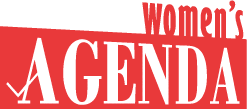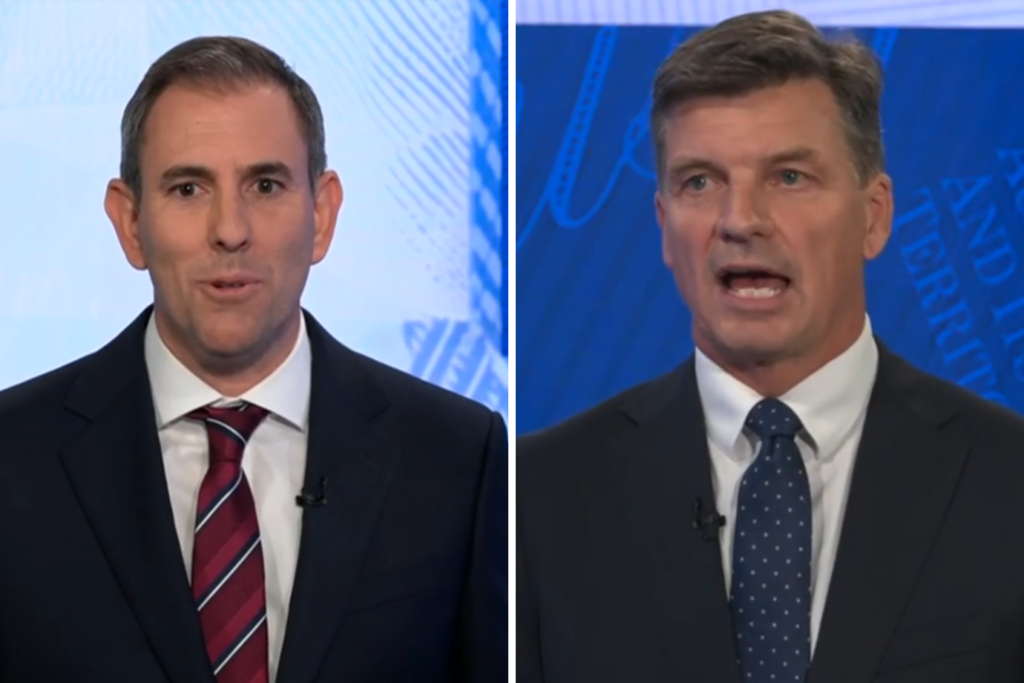If leadership was a wardrobe choice, the 2025 federal election would look like a navy suit, white shirt and coloured tie flecked with feckless promises.
That was the sartorial garb of choice in last night’s all-blokes in dark suits (so which tie won?) Treasurer’s Debate, and the previous night’s Sky News Leaders’ debate between Prime Minister Anthony Albanese and Opposition Leader Peter Dutton, which was less history-book making and more like back-aisle stoushing between two bumbling middle managers at Bunnings.
Even if you had the five bucks to fork out to Sky News and watch this all in real time (albeit in the crucible of a cost of living crisis), you didn’t miss very much.
Both debates featured lots of circle back to “get the economy moving” and deliver “downward pressure on inflation” in “uncertain times” for “ordinary Australians” who were likely already scoffing sausies at the proverbial barbie out the front anyway. (Way cheaper than the Sky News paywall. Shake damn hard on that free sauce, peeps! Makes the snags much more swallow-able. Like our politics).
In any case (and in case you do care about truths) – for the record – despite the fact that multiple social media accounts for the Liberal National Party promptly proclaimed Dutton had won the Leaders’ debate, he certainly did not. Of the 100 audience votes, Albanese won 44, Dutton won 35 and 21 people remained undecided. That’s the truth.
Or maybe no-one actually cares. Maybe truth just takes a quiet back seat in the face of the rhetorical right-down-the-empty-barrel Sky News “who do you trust?” sound bites, wide-eyed daily tariff spooks and giddy fifth gears of the election campaign spin cycle as the major parties try and haplessly lasso voters anywhere they are any which way they can on whatever platform they’ve got.
What is clear is that this election is being played out at warp speed in the Wild West of surface level politics. It’s more optics than outcomes in a blink-and-you’ll-miss-it TikTok reel – catchy, noisy and with a certain amount of whiplash and knee-jerk as we doom-scroll through democracy-lite posts dished up on relentless social media feeds.
But underneath the influencer cameos, dark suits and campaign circusury sits a much bigger question: What is this election really saying about the state of leadership in Australian politics today? And more importantly, what do Australians actually want that leadership to look like?
Judging by the polls, the answer is a little complicated. Anthony Albanese is still the preferred Prime Minister but Peter Dutton’s personal approval rating is bouncing around like a toddler on Red Bulls, with some voters in the outer suburbs and regions luke-warming to his good cop ‘back-on-track’ persona, even if he is trying to shake off the Peter Pan Trumpian shadow.
(Side note: Dutton’s proposal to ban remote work and slash public sector jobs and then his mind-bending WFH backflip won’t get him a ringside seat at the “Best Boss of the Year” awards but at least he is now ‘woke’ enough to realise that many women often, like, work from home and actually, like, vote).
If we look elsewhere for leadership and turn our attention to the Greens or the odd whack-a-mole media flash from other independent candidates here and there, we’re given glimpses of alternative versions of leadership. But for the most part the archetypal political leader is still mostly white, mainly middle-aged and clad in a one-size-fits-all electoral suit.
This means that, even in 2025, representative democratic leadership in Australia (and on Sky News debates to date) is still very badly lagging when it comes to reflecting the true diversity and complexity of the nation it claims to represent and – REMINDER – is supposed to democratically serve.
(To be fair this should come as no surprise given our woeful track record: In 2010, Julia Gillard became the first – and to date – only female Prime Minister of Australia. Still only one woman out of 31 prime ministers since Federation in 1901. What?)
Acknowledging that while some progress has been made toward gender equality in Australian elections, a new report from the Global Institute for Women’s Leadership at The Australian National University (ANU) shows in this federal election women still remain underrepresented among candidates.
The report published yesterday shows fewer women than men are running in the 2025 election and women are also more likely to be running in ‘glass cliff’ seats that are hard to win and precarious to hold. The ANU also reports that while women make up more than half (56 per cent) of the candidates being put forward by the Australian Labor Party (ALP), less than a third (32 per cent) of the Coalition’s candidates are women.
The report also highlights the ongoing issue of a lack of overall diversity in modern Australian politics. While 21 per cent of candidates in this election identify as belonging to underrepresented or diverse groups, this figure remains lower than current representation in Parliament.
So with this mainly white, mainly men and mainly dark-suited smorgasbord of candidates, at this election voters are having to make do with a pretty limited choice on the political runway, settling for one-size-fits-all representatives who rarely understand or speak for the lived experiences or core concerns of the people in their electorates.
Given this ill-fit, so far, women have watched gender equity get trotted out on the campaign trail like a side of salty fries – a quick bite between the meatish burgers of budget forecasts and yeasty buns of border talk.
There are mentions of diversity and “listening” and policies for “ordinary Australians” but what women actually need right now is extraordinary political leadership and more policy commitments that talk to them directly.
Policy that addresses the fact that the women who make up more than half the Australian voting population are more educated than ever before but still earn less than men (for every $1 on average a man makes, women earn 78 cents).
Policy that addresses the fact that women in this country still retire with 25 per cent less super than men, are one of the fastest growing homeless groups and continue to shoulder the disproportionate burden of care (for infants, kids, siblings, parents and communities).
Policy that recognises that these are voting women who juggle jobs (yes often from home) while balancing household budgets in an escalting cost of living and violence against women crisis plus manage the mental health of family members (and themselves) in an increasingly fragile VUCA world.
Their votes matter. Their voices should be heard. Their issues should be front and centre. Tabled by leaders who aren’t wearing one size fits all.
Feature image: Jim Chalmers and Angus Taylor during the debate.
Support Women’s Agenda! We are 100% independent and women-owned. We’re covering the Federal Election from the perspective of what matters to women, and always keeping the issues that matter for women on the daily agenda. Foundation memberships are just $5 a month.
Bonus: you’ll receive our weekly editor’s wrap of the key stories to know every Saturday. Become a member here.


